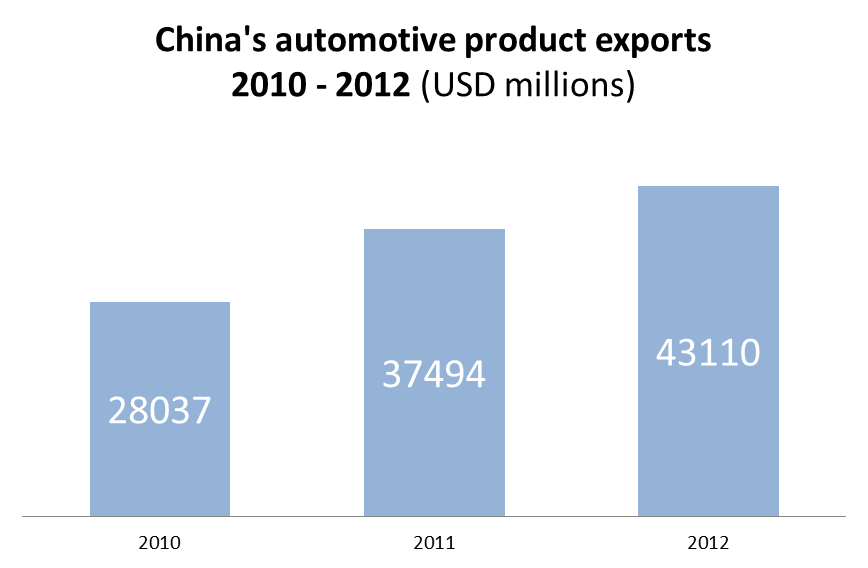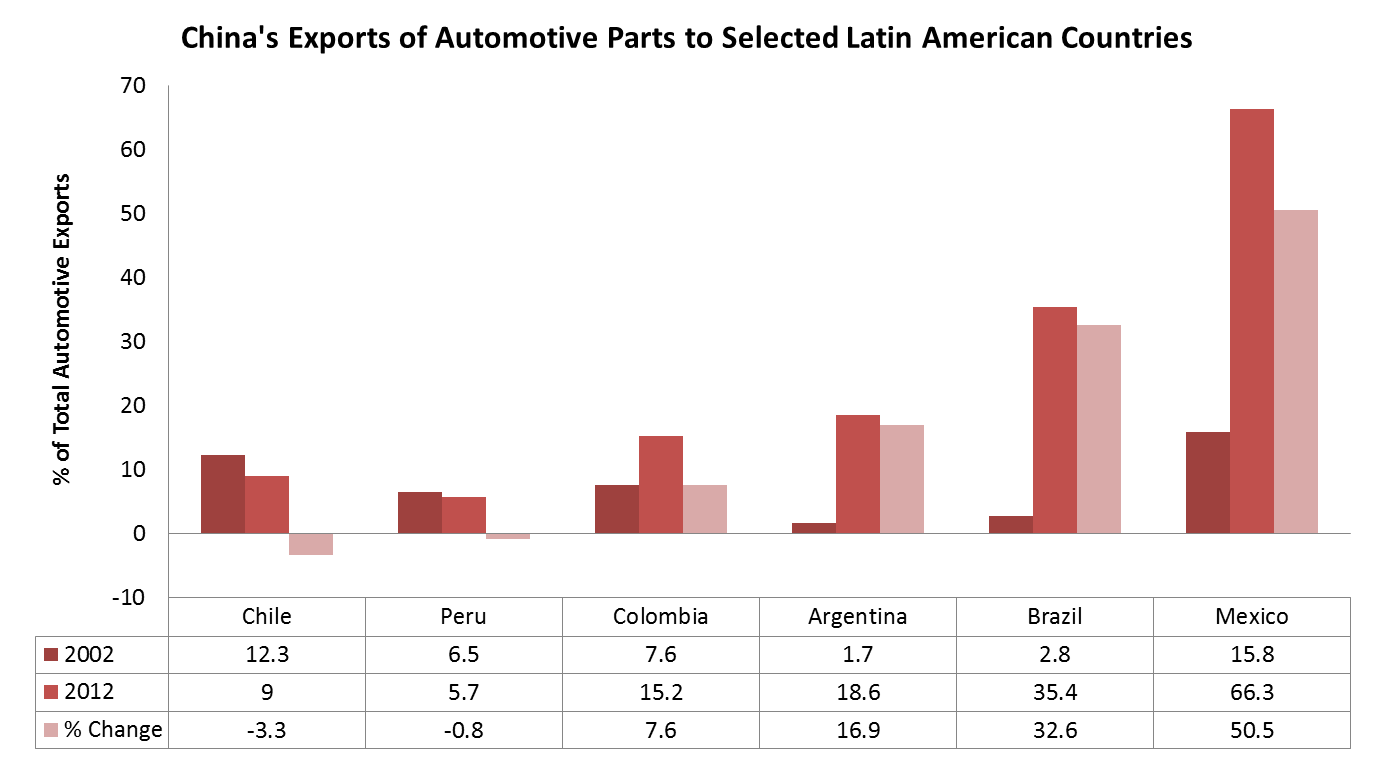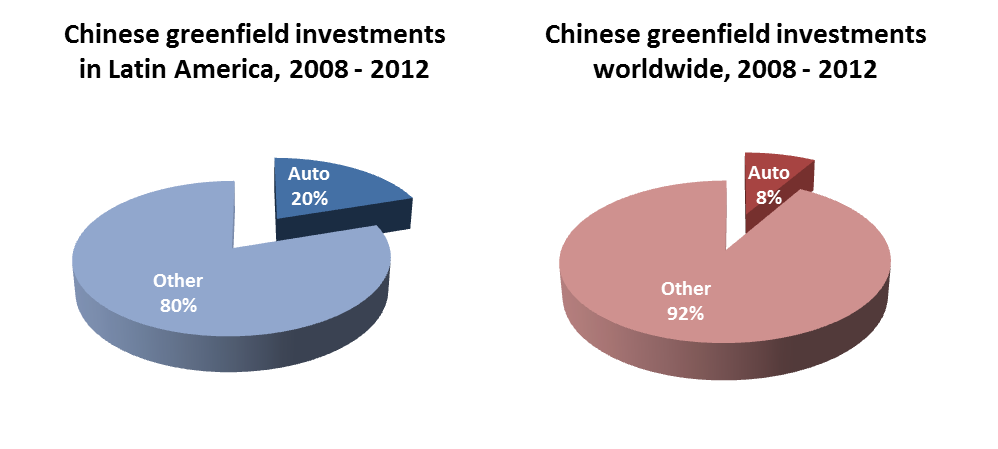
Mexican vs Chinese Factories
With the rising cost of wages in China, manufacturers are increasingly considering Mexico an attractive location to ‘re-shore’ production.

China represents the world’s largest auto market, and in 2009 surpassed Japan to become the world’s leading auto producer. Although only 4 percent of Chinese cars are exported, trade in automotive products has grown rapidly. Exports of vehicles and auto parts grew by more than 500 percent between 1990 and 2000, and the value of auto exports in 2010 was 16 times higher than in the previous decade. In the past year, several of the country’s top auto producers have unveiled new strategies for overseas expansion.
Chinese carmakers are flocking to Latin America as the country’s auto industry looks to expand international sales. Rising incomes have increased demand for vehicles in Brazil, Argentina and Colombia, in particular. Latin American nations have generally been more welcoming of Chinese auto imports than several of China’s neighbors – notably India, Japan, and South Korea. These countries boast well-established auto manufacturing sectors, while countries in Southeast Asia such as Thailand, Malaysia and Indonesia have imposed tariffs while developing domestic production.
China’s engagement with Latin America’s auto sector is characterized by four trends:
Chinese automotive manufacturers enjoy cost advantages relative to major competitors from the United States, Europe and Japan, thanks to significant economies of scale achieved in China’s domestic market and the country’s still relatively low labor costs. Selling vehicles at a fraction of competitors’ costs, Chinese producers have gained traction despite poor name recognition in Latin America. The region more than doubled its share of Chinese auto exports between 2006 and 2012, with Brazil becoming the single largest destination for vehicles assembled in China in 2011.
China’s automakers such as JAC Motors, Chery, Lifan, and Dongfeng have achieved the greatest degree of market penetration in Peru and Chile, where Chinese cars make up 15 percent and 11 percent of total sales, respectively. And while China still falls short of the United States, Japan and Europe in auto trade, Chinese exports have expanded dramatically at a pace averaging nearly 30 percent annually since 2005. The country’s exports to Latin America are projected to expand further in 2014 and the coming decade.
While China’s auto trade with Latin America has increased dramatically over the past decade. Chinese exporters made the greatest gains in South America, where total value of exports to Argentina, Brazil, Chile and Peru increased by more than 4000 percent between 2002 and 2012. Growth in Chinese exports to Mexico was more modest but still exceeded 1000 percent over the course of the decade.
Finished or partly assembled vehicles account for more than 90 percent of Chinese auto exports to Peru and Chile. China’s free trade agreements with both countries reduced tariffs on its auto exports, allowing Chinese firms to increase car sales.
In contrast, China’s auto trade with Mexico and Brazil consists mostly of auto parts for assembly. Auto parts skyrocketed as a percentage of China’s total trade with both countries over the past decade, and now account for roughly two thirds of Mexico’s auto imports from China and one third of Brazil’s. Rising production by American, European and Japanese automakers, which increasingly utilize Chinese-made auto parts in their vehicles, is driving increases in demand in both countries. At the same time, China’s automakers are facing greater barriers to entry for finished vehicles – including import restrictions, local content requirements and greater competition from other firms.

Between 2006 and 2012, China announced a total of nearly 6 billion dollars of auto related investments in Latin America, according to the UN Economic Commission on Latin America (ECLAC). The majority of Chinese new plants will be located in Brazil, where booming demand is projected to rise to 6.6 million vehicles by 2020 – twice the country’s demand in 2010. The largest projects include a Chery plant in Sao Paulo worth 400 million dollars and a 510 million dollar planned investment by JAC Motors in the Northeast part of the country. The China-Brazil Business Council estimates that investments in the automotive sector account for 22 percent of all Chinese investment in the country between 2007 and 2012, the greatest share of any single industry.
Yet projects have been slower than expected to materialize in Brazil and neighboring Argentina, which together account for most of South America’s demand for vehicles. Brazil’s implementation of stringent local content requirements in 2011 delayed major Chinese investments there, and Argentina’s restrictions automobile imports could have a similar effect. Uruguay and Paraguay, which have preferential trade access with Argentina and Brazil through Mercosur, have absorbed some of these displaced production and now export vehicles produced by Chinese firms to both Brazil and Argentina. Production chains may become even more complex in the future as firms navigate rules of origin, trade restrictions, exchange rate issues and local content requirements in Latin America’s major auto markets.
While emerging markets account for most Chinese auto sales, reaching US markets has become a priority for a number of Chinese companies. “I want Lifan to be the best automobile and motorcycle company in the world,” Yin Minshan, president of Lifan motors group, told newspaper China Daily. “To achieve this, it is important for us to increase our presence in global markets, especially the US market, one of the most important and developed auto markets there is.” Rigorous auto standards in the United States remain a critical barrier for many Chinese auto firms, however. Operating in Latin America and other regions provides companies like Lifan with a crucial foothold and the opportunity to compete in a tougher regulatory environment. Firms including Dongfeng and FAW have also expressed interest in establishing plants in Mexico, which would serve as a platform for vehicle exports to the United States and Canada.
The auto sector accounted for nearly 20 percent of all Chinese greenfield investments in Latin America between 2008 and 2012, and 17 percent of new Chinese investments in Brazil in 2012 alone. Rather than import prefabricated vehicles from China, companies such as JAC Motors, Chery, Geely, Lifan, and Dongfeng have established or plan to operate production centers in the region. New factories located in Latin America will trim costs associated with transportation and logistics and reduce import duties on Chinese auto products in certain countries.

Unlike Chinese firms in most other sectors, China’s automakers have not demonstrated interest in mergers and acquisitions in Latin America. Transnational companies control most production in Latin America and China’s relatively advanced auto producers have less to learn from the region’s few indigenous auto producers than Chinese firms operating in other sectors. Companies may also be put off by higher production costs and relatively inflexible labor policies in the region.
Instead, Chinese automakers have pursued a number of alternative strategies to bolster local engagement and support knowledge development. Chery joined with Argentina’s SOCMA Group in 2007 to build a 500 million dollar plant in Uruguay, one of the first Chinese automotive projects announced in the region. Another Chinese auto producer, Lifan, has opted to establish its own 70 million dollar research and development center in Brazil to support operations there.
The first forays of China’s auto companies in Latin America have been largely successful. While exports in auto parts have boomed, car makers have established markets for finished vehicles in Chile and Peru. Despite remaining impediments to trade and investment in the auto sector in certain countries, Chinese firms successfully established new production centers throughout the region and are paving the way for further expansion. The role of Chinese automakers in Latin America will continue to grow in the coming years. And as it does, it may serve as a model for China’s expansion in other emerging markets such as Africa and the Middle East.
With the rising cost of wages in China, manufacturers are increasingly considering Mexico an attractive location to ‘re-shore’ production.
Colombian firm Interbolsa is being liquidated in a move to protect the interests of Colombia’s financial markets.
What is the state of Peru-China commercial ties today?